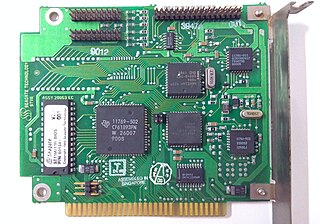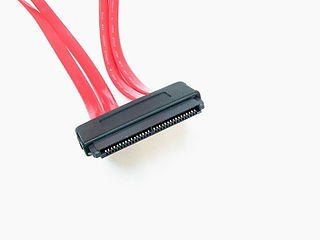In the field of storage area networks, the iSCSI Management API (IMA) is a SNIA's standard for managing both iSCSI initiators and hosts containing them.
In the field of storage area networks, the iSCSI Management API (IMA) is a SNIA's standard for managing both iSCSI initiators and hosts containing them.
In computing, a device driver is a computer program that operates or controls a particular type of device that is attached to a computer or automaton. A driver provides a software interface to hardware devices, enabling operating systems and other computer programs to access hardware functions without needing to know precise details about the hardware being used.

Small Computer System Interface is a set of standards for physically connecting and transferring data between computers and peripheral devices. The SCSI standards define commands, protocols, electrical, optical and logical interfaces. The SCSI standard defines command sets for specific peripheral device types; the presence of "unknown" as one of these types means that in theory it can be used as an interface to almost any device, but the standard is highly pragmatic and addressed toward commercial requirements. The initial Parallel SCSI was most commonly used for hard disk drives and tape drives, but it can connect a wide range of other devices, including scanners and CD drives, although not all controllers can handle all devices.
In computing, iSCSI is an acronym for Internet Small Computer Systems Interface, an Internet Protocol (IP)-based storage networking standard for linking data storage facilities. It provides block-level access to storage devices by carrying SCSI commands over a TCP/IP network. iSCSI is used to facilitate data transfers over intranets and to manage storage over long distances. It can be used to transmit data over local area networks (LANs), wide area networks (WANs), or the Internet and can enable location-independent data storage and retrieval.

The Macintosh Plus computer is the third model in the Macintosh line, introduced on January 16, 1986, two years after the original Macintosh and a little more than a year after the Macintosh 512K, with a price tag of US$2,599. As an evolutionary improvement over the 512K, it shipped with 1 MB of RAM standard, expandable to 4 MB, and an external SCSI peripheral bus, among smaller improvements. Originally, the computer's case was the same beige color as the original Macintosh, Pantone 453; however, in 1987, the case color was changed to the long-lived, warm gray "Platinum" color. It is the earliest Macintosh model able to run System Software 5, System 6, and System 7.

The disk controller is the controller circuit which enables the CPU to communicate with a hard disk, floppy disk or other kind of disk drive. It also provides an interface between the disk drive and the bus connecting it to the rest of the system.

The Power Macintosh G3 is a series of personal computers designed, manufactured, and sold by Apple Computer, Inc. from November 1997 to August 1999. It represented Apple's first step towards eliminating redundancy and complexity in the product line by replacing eight Power Macintosh models with three: Desktop and Mini Tower models for professional and home use, and an All-In-One model for education. The introduction of the Desktop and Mini Tower models coincided with Apple starting to sell build-to-order Macs directly from its web site in an online store, which was unusual for the time as Dell was the only major computer manufacturer doing this. Apple's move to build-to-order sales of the Power Macintosh G3 also coincided with the acquisition of Power Computing Corporation, which had been providing telephone sales of Macintosh clones for more than two years.

In computer hardware, a host controller, host adapter, or host bus adapter (HBA), connects a computer, which acts as the host system, to other network and storage devices. The terms are primarily used to refer to devices for connecting SCSI, Fibre Channel and SATA devices. Devices for connecting to IDE, Ethernet, FireWire, USB and other systems may also be called host adapters.
In computer storage, a logical unit number, or LUN, is a number used to identify a logical unit, which is a device addressed by the SCSI protocol or by Storage Area Network protocols that encapsulate SCSI, such as Fibre Channel or iSCSI.

In computing, Serial Attached SCSI (SAS) is a point-to-point serial protocol that moves data to and from computer-storage devices such as hard disk drives and tape drives. SAS replaces the older Parallel SCSI bus technology that first appeared in the mid-1980s. SAS, like its predecessor, uses the standard SCSI command set. SAS offers optional compatibility with Serial ATA (SATA), versions 2 and later. This allows the connection of SATA drives to most SAS backplanes or controllers. The reverse, connecting SAS drives to SATA backplanes, is not possible.
In computer data storage, a SCSI initiator is the endpoint that initiates a SCSI session, that is, sends a SCSI command. The initiator usually does not provide any Logical Unit Numbers (LUNs).

The NCR 53C9x is a family of application-specific integrated circuits (ASIC) produced by the former NCR Corporation and others for implementing the SCSI bus protocol in hardware and relieving the host system of the work required to sequence the SCSI bus. The 53C9x was a low-cost solution and was therefore widely adopted by OEMs in various motherboard and peripheral device designs. The original 53C90 lacked direct memory access (DMA) capability, an omission that was addressed in the 53C90A and subsequent versions.
PowerVault is a line of data storage and backup products formerly from Dell, and currently for Dell EMC.
In SCSI computer storage, computers and storage devices use a client-server model of communication. The computer is a client which requests the storage device to perform a service, e.g., to read or write data. The SCSI command architecture was originally defined for parallel SCSI buses but has been carried forward with minimal change for use with Fibre Channel, iSCSI, Serial Attached SCSI, and other transport layers.
The Apple Network Server (ANS) was a line of PowerPC-based server computers designed, manufactured and sold by Apple Computer, Inc. from February 1996 to April 1997. It was codenamed "Shiner" and originally consisted of two models, the Network Server 500/132 and the Network Server 700/150, which got a companion model, the Network Server 700/200 with a faster CPU in November 1996.

Parallel SCSI is the earliest of the interface implementations in the SCSI family. SPI is a parallel bus; there is one set of electrical connections stretching from one end of the SCSI bus to the other. A SCSI device attaches to the bus but does not interrupt it. Both ends of the bus must be terminated.

AppleCD is a range of SCSI-based CD-ROM drives for Apple Macintosh personal computers, manufactured and sold by Apple Computer from the late 1980s to late 1990s. Earlier AppleCD drives required a CD caddy in order to be used, while later models used a tray-loading mechanism. The original model introduced in 1988 was simply called the AppleCD SC. There was also a version of the CD drive that did not have the Apple logo.

VMware ESXi is an enterprise-class, type-1 hypervisor developed by VMware for deploying and serving virtual computers. As a type-1 hypervisor, ESXi is not a software application that is installed on an operating system (OS); instead, it includes and integrates vital OS components, such as a kernel.

The Apple Hard Disk 20SC is Apple's first SCSI based hard drive for the Apple II family as well as the Macintosh and other third party computers using an industry standard SCSI interface.

A storage area network (SAN) or storage network is a computer network which provides access to consolidated, block-level data storage. SANs are primarily used to access data storage devices, such as disk arrays and tape libraries from servers so that the devices appear to the operating system as direct-attached storage. A SAN typically is a dedicated network of storage devices not accessible through the local area network (LAN).

In computing, Linux-IO (LIO) Target is an open-source implementation of the SCSI target that has become the standard one included in the Linux kernel. Internally, LIO does not initiate sessions, but instead provides one or more Logical Unit Numbers (LUNs), waits for SCSI commands from a SCSI initiator, and performs required input/output data transfers. LIO supports common storage fabrics, including FCoE, Fibre Channel, IEEE 1394, iSCSI, iSCSI Extensions for RDMA (iSER), SCSI RDMA Protocol (SRP) and USB. It is included in most Linux distributions; native support for LIO in QEMU/KVM, libvirt, and OpenStack makes LIO also a storage option for cloud deployments.